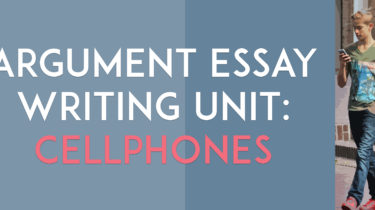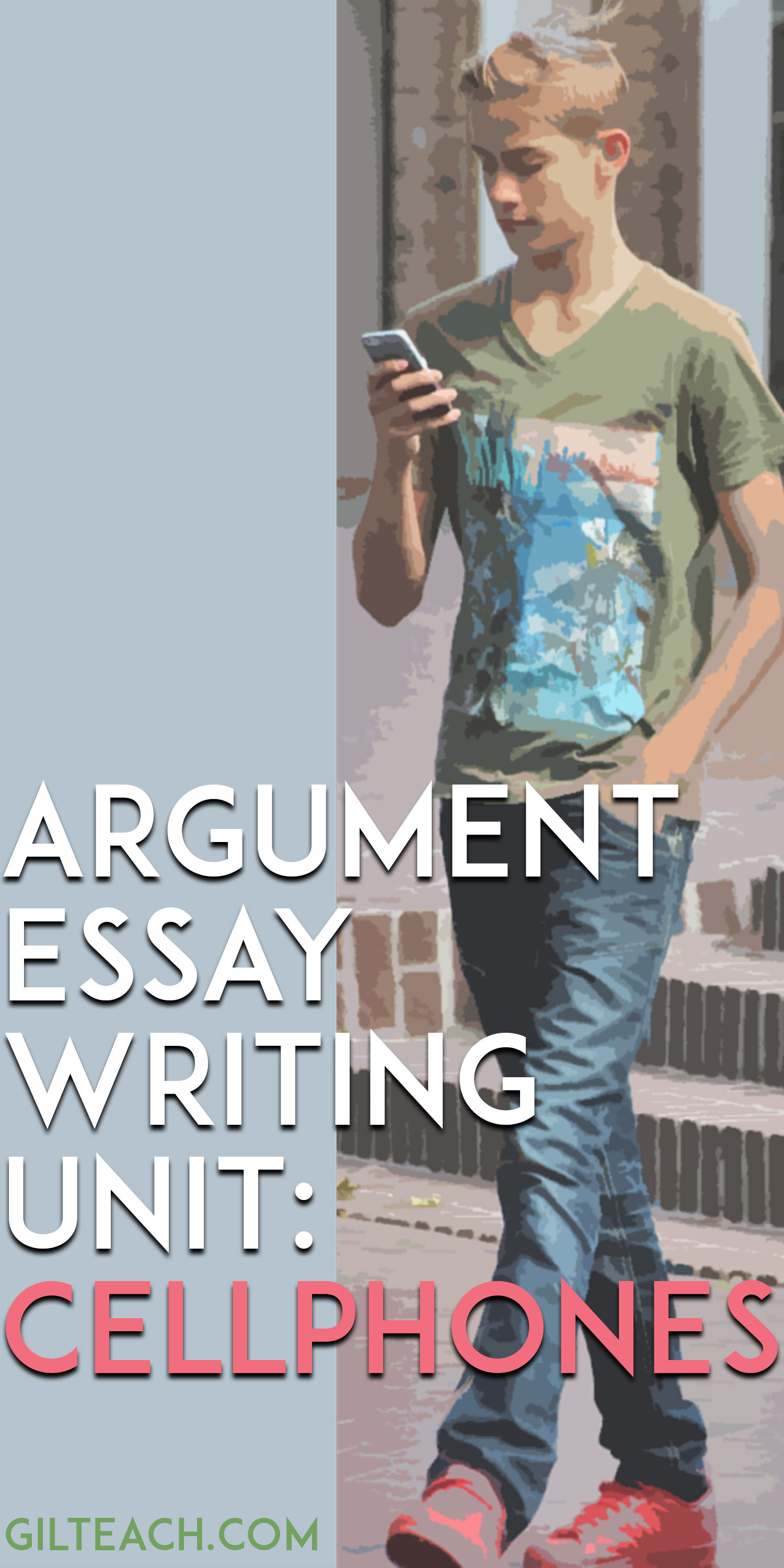Argument Essay Unit: Cellphone Pros and Cons

I have to admit that I resisted teaching a research based argument essay in my ELA classes for over twelve years. Each year, I would “forget” or “not get to it” or “sort of do an assignment that fulfills the requirement.” The requirement, as I understood it, was for students to click around on the internet for a few hours, put some facts together in a new format, and then say where they had gotten that information. It seemed like a huge waste of time that took away from what I really wanted to teach my students: how to analyze texts, think critically, and write effectively.
But I could only hide from the requirement for so long, and so eventually I gave in and assigned a research paper to my students. At the time, I was still in the classroom, and any planning time that I could find was what was left over in a 45 minute period after I ran to the bathroom, got a drink of water, checked my email, graded the quizzes that had been sitting on my desk for a week, and picked up the trash off the floor. In other words, I could do the bare minimum, but that’s about it. I did the best that I could with the time that I had, and I think that my classes learned a few things.
Now, I am no longer in the classroom, and I am designing resources to sell on Teachers Pay Teachers. What this means is that I have the time to create the lesson plans that I always wanted but didn’t have the time to make.
So I decided to create an argument unit that I would have taught if I had time.
This is the how my Argument Writing Lesson Plans To Meet Common Core Standards are structured.
I decide the topic. For this unit, it’s all about cellphones. For the most part, I am not a fan of micromanaging every aspect of my students’ experiences, but in this case, I wanted to decide what they would read. I have found that teenagers are super addicted and also surprisingly ignorant about cellphones—this is a topic that they want and need to learn about. By vetting the research sources myself, I could be sure that students won’t be reading cheesy pro-con websites or other questionable sources. It also allows teachers to focus on the hard stuff—writing a thesis, integrating sources, and figuring out how to put together a multi-page argument essay.
It all starts with some funnies. I know as well as any teacher that the trick to hooking students is engaging them from the beginning, so this unit starts off with discussion questions to analyze three comics about cellphones. Students get to start off by laughing at others (and themselves) and the ridiculous habits that we all have with our phones. They also start to think right off the bat about some of the bigger issues involved in device usage and maybe addiction.
Students then spend some time reading authentic mentor texts that will also be their sources. I read through dozens of articles in the best publications before deciding on the ones that had the best mix of accessibility and quality writing. The questions that I developed for the pieces focus on both content and writer’s craft. So students will examine facts and studies and ideas about cellphones, and they will also look at grabbers and topic sentences and the ways that writers integrate facts into their argument. The questions encourage close careful reading as well as a discussion of the big ideas. So students will complete the first piece of their research while they learn about how writers form effective arguments.
Then students dig deeper into the research by reading more articles chosen for them. There are two categories that students can choose from, based on what interests them most in those initial articles. Rather than task students with reading all of the articles and then deciding which to utilize, they choose one article to read carefully, then they share their findings in a jigsaw. Once they have shared with their classmates, they choose a few articles that seem promising and relevant to their interests, and gather more evidence from those.
Students then write their thesis statements based on what they have read. My idea is that students’ thinking in these papers, like all good analytical thinking, should start with a general idea that comes from the evidence. Rather than tasking students with writing a thesis first and then finding evidence to support it, which is a great way to create close-minded thinkers who refuse to understand other points of view, I have them write a draft statement after they have read their sources.
They write the papers in a writing workshop format with mini lessons that refer back to those mentor texts. Rather than expecting students to take some research home and come back in a few days with a perfectly written research paper (a mistake that I may have made once or twice!), the rest of the unit takes the form of a writing workshop. Students are expected to view their pieces as works in progress. They work on drafts, and then they work to clarify their ideas, reevaluate their evidence, and improve their grabbers, organization, citation, and counterclaim all by participating in mini lessons based on the articles that they read at the beginning of the unit.
They conference with teachers and with each other to improve their writing. My journey to getting students to work effectively with each other on their drafts has been a rocky one to say the least, but I’ve finally figured out some strategies and techniques to show them how much they can learn from each other and to keep them on track when they are working together. Teacher conferences can also be tricky. But since I have figured out how useful a timer and a checklist can be, I’ve become a huge fan of conferencing with students about their writing on a regular basis.
I spent years avoiding teaching my students to write research based argument essays, but if I had all of these plans in place for all of those years, I wouldn’t have skipped over the unit for sure.
Want to teach argument essay writing with this format? Want to teach this unit tomorrow? Check it out here.
